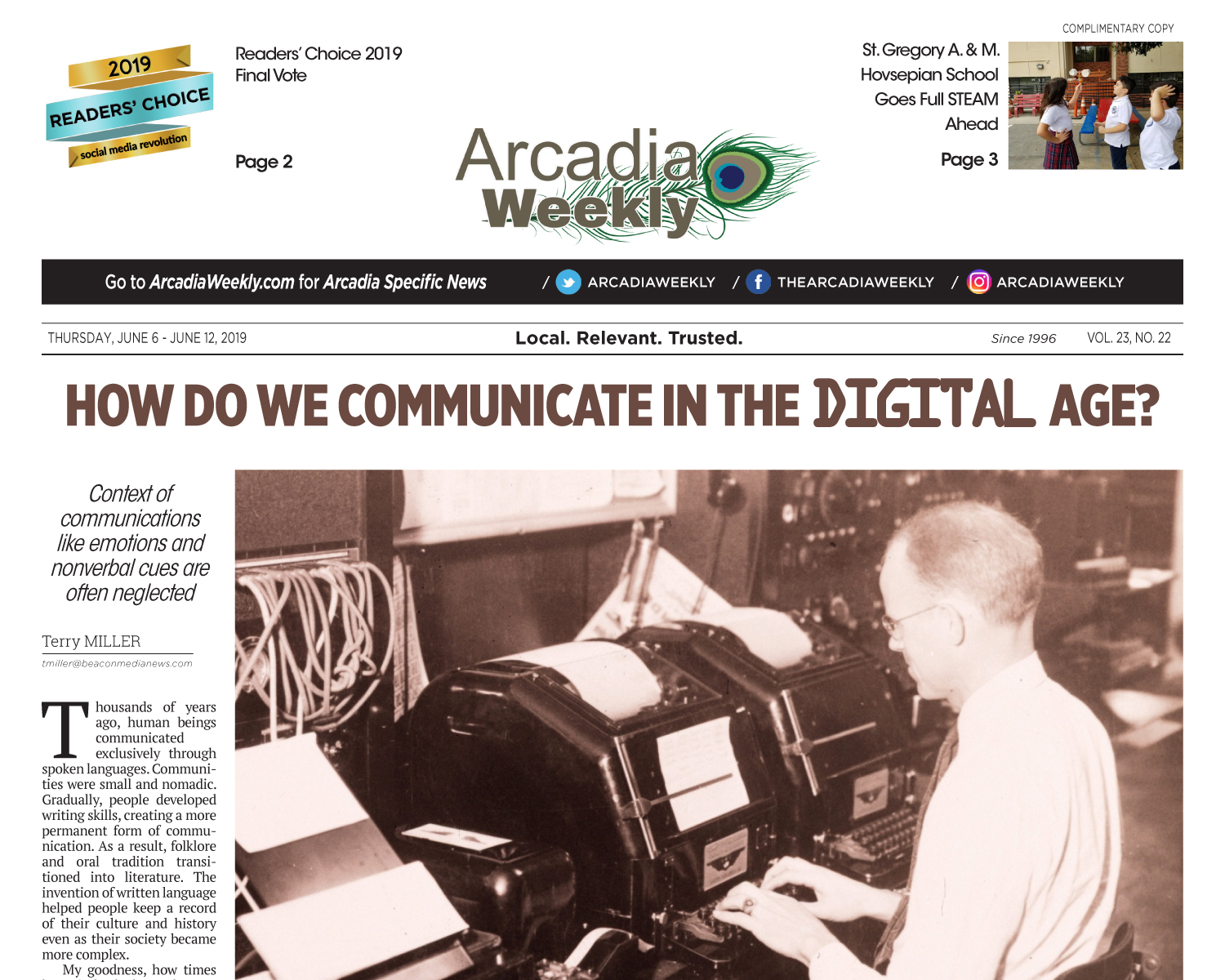
Context of communications like emotions and nonverbal cues are often neglected
By Terry Miller
Thousands of years ago, human beings communicated exclusively through spoken languages. Communities were small and nomadic. Gradually, people developed writing skills, creating a more permanent form of communication. As a result, folklore and oral tradition transitioned into literature. The invention of written language helped people keep a record of their culture and history even as their society became more complex.
My goodness, how times have indeed changed. Even the ‘Old Grey Lady’ — the Iconic New York Times — reluctant to print in color finally did so in 1997. This was just the beginning of the digital transformation that took this industry by the boot straps. Although, the first newspaper to go online was actually the Columbus Dispatch in 1980.
Ironic, isn’t it, that an employee of Eastman Kodak was the inventor of the first digital camera and then that same company that was reticent to join the digital revolution files for bankruptcy in 2012?
I personally recall, with some trepidation, not having to develop and print negatives anymore thanks to the mind-blowing new technology that literally changed the way we communicate. All of a sudden I had instant images, not Polaroids, but a good likeness using a digital binary code.
Film was essentially history and images were stored on a disc inside the camera and transferred to a computer for transmission to points unknown.
The earliest digital camera cost over $20,000 and had very little memory or megapixel capacity as do the current incredible camera lineups from multiple manufacturers.
It wasn’t so long ago that newspapers had to wire photos and many used the old Telex machine to transmit copy worldwide. In years not so long past, photographers actually used carrier pigeons to get their film to the newspaper lab for developing and printing, in time to make the late editions.
These telex machines, which now are only seen in museums, were the lifeblood of newsrooms’ words across the globe.
The way that we present our journalism has changed over the years but the core of what we create has remained the same.
Until entering the digital age, our only reader feedback was through print sales and letters to the editor. Now we have access to so much more. As a subscription business in a world of free news, we must make our value clear in order to grow and retain our readers. However, as that growth has led to a larger digital base than print in some cases, that value is no longer as straightforward as stories in a newspaper, according to some in the industry.
It seems social media has taken a deep and perplexing plunge into our subconscious and in doing so has forever changed the way we communicate. We not only have to write for the average reader but we must also ensure that our online stories carry the maximum punch with a thing called SEO (search engine optimization) or appeal to our Instagram followers.
This evolution, which has bred a whole brave new world of specialists in the field, quite frankly bewilders this reporter, at times.
Digital communication has also really hit Hallmark hard. Birthday cards and invitations to a get together are “so yesterday.”
Who now, ever sends a greeting card? For that matter, when was the last time you sent a hand written letter to a friend or relative. It’s now an e-card, or an e-vite flooding your email inbox with lightning speed. Then there is the dreaded spam. Luckily, most of our email providers do a pretty good job of filtering such devious digital demons but alas, on occasion, one might get through.
Cell phones have become so popular over the last couple of decades we’ve already seen consumer behavior change as a result. The rise in popularity of SMS messages — better known as text messages — has overtaken voice calls [source: Reardon]. The United States Census Bureau estimated the total number of text messages sent by U.S. citizens at around 110 billion [source: U.S. Census Bureau].
Social networks have made a big impact on behavior as well. A survey by Prompt Communications in 2009 found that more respondents used Facebook to stay in touch with friends and family than e-mail or SMS messages.
But will digital communication change behavior beyond how we choose to send and receive messages?
According to American University in Washington D.C.:
“The rapid development and adoption of new technology has changed the face of communication through traditional media. The word of the day, according to the Newspaper Association of America, is innovation. Professional journalists in print and broadcast media have had to compete with amateur publishers for readers’ limited attention spans. Media organizations that fail to keep current on communication technology may find themselves swallowed up by other more agile organizations that can. Web-based and mobile apps like Twitter, Instagram, and Facebook are often the first places readers go when they want breaking news. Respondents to Reuters Institute’s 2015 Digital News Report indicated how individuals consume news:
- 11% paid for news online
- 26% accessed it through a smartphone
- 32% shared news stories through email and social media
“In researching the aspects and effects of digital imaging we found effective communication is ultimately about human interactions. Communication occurs in both verbal and nonverbal forms.”
Digital communication employs technologies such as computers, mobile devices, and even television sets to communicate. The form of the communications can be emails, social media platforms like Twitter and Facebook, or video technologies like Skype and YouTube. Technology is providing the connection, instead of face-to-face interactions. Especially in written digital communications, the context of communications, including emotions and nonverbal cues that play such an important role in cultures, might be missed or absent.
Careless communication can have catastrophic implications. Hopefully with all this remarkable technology we can evolve as did our forefathers.






